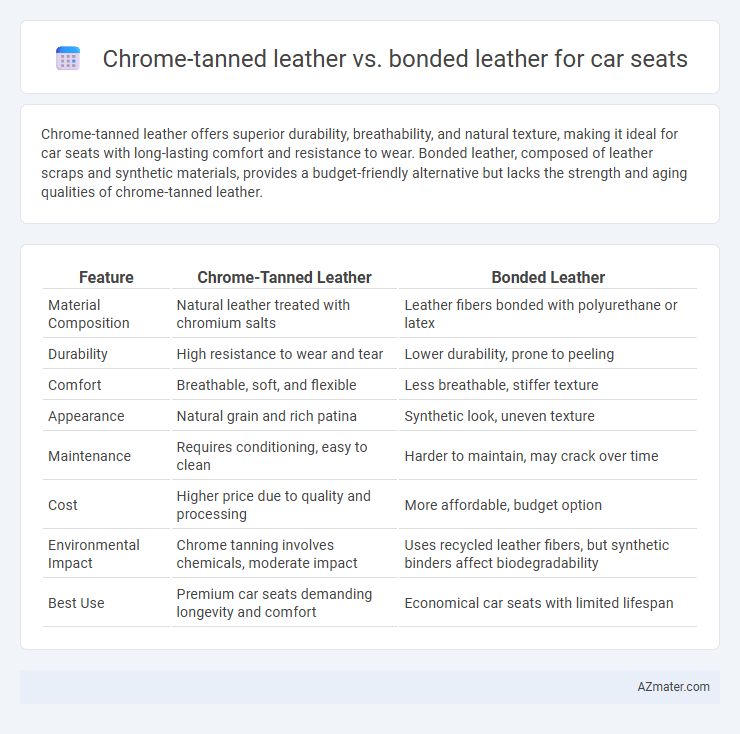Chrome-tanned leather offers superior durability, breathability, and natural texture, making it ideal for car seats with long-lasting comfort and resistance to wear. Bonded leather, composed of leather scraps and synthetic materials, provides a budget-friendly alternative but lacks the strength and aging qualities of chrome-tanned leather.
Table of Comparison
| Feature | Chrome-Tanned Leather | Bonded Leather |
|---|---|---|
| Material Composition | Natural leather treated with chromium salts | Leather fibers bonded with polyurethane or latex |
| Durability | High resistance to wear and tear | Lower durability, prone to peeling |
| Comfort | Breathable, soft, and flexible | Less breathable, stiffer texture |
| Appearance | Natural grain and rich patina | Synthetic look, uneven texture |
| Maintenance | Requires conditioning, easy to clean | Harder to maintain, may crack over time |
| Cost | Higher price due to quality and processing | More affordable, budget option |
| Environmental Impact | Chrome tanning involves chemicals, moderate impact | Uses recycled leather fibers, but synthetic binders affect biodegradability |
| Best Use | Premium car seats demanding longevity and comfort | Economical car seats with limited lifespan |
Introduction to Car Seat Leathers
Car seat leathers primarily include chrome-tanned and bonded leather, each offering distinct characteristics. Chrome-tanned leather is valued for its durability, supple texture, and resistance to wear, making it ideal for high-quality automotive interiors. Bonded leather, made from leather scraps bonded with polyurethane, provides a more affordable option but lacks the longevity and breathability of genuine chrome-tanned leather.
What is Chrome-Tanned Leather?
Chrome-tanned leather is a type of leather treated with chromium salts to create a soft, supple, and durable material ideal for car seats. This tanning process enhances resistance to wear, moisture, and temperature changes, making it more durable than bonded leather. Unlike bonded leather, which is made from leather scraps bonded together with adhesives, chrome-tanned leather retains the natural texture and breathability of genuine leather.
What is Bonded Leather?
Bonded leather is a composite material made by combining shredded genuine leather scraps with polyurethane or latex, creating a cheaper and less durable alternative to traditional leather. Unlike chrome-tanned leather, which is treated with chromium salts for enhanced softness and durability, bonded leather lacks the same structural integrity and breathability, making it less suitable for long-term car seat use. Its synthetic composition often results in quicker wear and reduced comfort compared to the high-quality finish of chrome-tanned leather.
Durability Comparison: Chrome-Tanned vs Bonded Leather
Chrome-tanned leather offers superior durability and resistance to wear, making it ideal for car seats subjected to frequent use and varying temperatures. Bonded leather, composed of shredded leather fibers bonded with polyurethane or latex, tends to degrade faster, showing signs of peeling and cracking under stress. The inherent strength and flexibility of chrome-tanned leather significantly outperform bonded leather in maintaining seat integrity and appearance over time.
Comfort and Feel: Which Leather Offers Better Experience?
Chrome-tanned leather provides a soft, supple texture that adapts well to body contours, offering enhanced comfort and a luxurious feel ideal for car seats. Bonded leather, composed of shredded leather fibers mixed with polyurethane, lacks the natural breathability and smoothness, often resulting in a stiffer and less comfortable surface. The superior durability and moisture-wicking properties of chrome-tanned leather contribute to a more pleasant and lasting seating experience compared to bonded leather.
Appearance and Aesthetic Differences
Chrome-tanned leather offers a smooth, supple surface with natural grain patterns and rich color depth, enhancing the luxury appearance of car seats. Bonded leather, made from shredded leather fibers mixed with polyurethane, often lacks consistent texture and displays a more synthetic, uniform look that can appear less refined. The distinct natural imperfections and vibrant hues of chrome-tanned leather provide a more authentic and premium aesthetic compared to the flat, artificial finish typical of bonded leather.
Maintenance and Cleaning Requirements
Chrome-tanned leather car seats require regular cleaning with a damp cloth and occasional conditioning to maintain suppleness and prevent cracking, as the chemical tanning enhances durability but can dry out over time. Bonded leather seats need more frequent cleaning due to their composite nature and susceptibility to peeling; mild soap and water work best, avoiding harsh chemicals that can deteriorate the synthetic materials. Both materials benefit from protection against direct sunlight and spills to prolong lifespan and maintain appearance.
Environmental Impact of Both Types
Chrome-tanned leather involves heavy metal chemicals such as chromium, which can cause significant environmental pollution during tanning and waste disposal, impacting water quality and soil health. Bonded leather, made from shredded leather scraps mixed with polyurethane or latex, often incorporates synthetic materials that are less biodegradable and may release microplastics, raising concerns about long-term environmental sustainability. Choosing eco-friendly alternatives or vegetable-tanned leather can reduce harmful environmental effects linked to conventional chrome-tanned and bonded leather used in car seats.
Cost Analysis: Chrome-Tanned vs Bonded Leather
Chrome-tanned leather costs significantly more than bonded leather due to its labor-intensive tanning process and higher quality raw materials, typically ranging from $50 to $100 per square foot compared to $10 to $20 for bonded leather. While bonded leather offers a budget-friendly option by combining leather scraps with polyurethane, it tends to wear out faster and may require replacement sooner, increasing long-term expenses. Investing in chrome-tanned leather for car seats generally provides better durability and maintains value over time despite the higher initial cost.
Which Leather is Best for Your Car Seats?
Chrome-tanned leather offers superior durability, water resistance, and a soft, supple texture ideal for car seats requiring long-lasting comfort and easy maintenance. Bonded leather, made from leather scraps mixed with polyurethane, is more affordable but less durable and prone to cracking and peeling over time, making it less suitable for high-use car interiors. For optimal performance and longevity in car seats, chrome-tanned leather is the best choice due to its strength and premium feel.

Infographic: Chrome-tanned leather vs Bonded leather for Car seat
 azmater.com
azmater.com